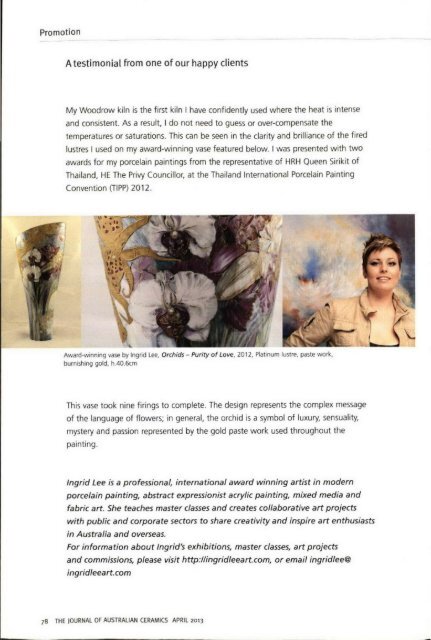The Journal of Australian Ceramics Vol 52 No 1 April 2013
Create successful ePaper yourself
Turn your PDF publications into a flip-book with our unique Google optimized e-Paper software.
Promotion<br />
woodrow<br />
kilns<br />
Hi, I'm Adam Crozier the new owner <strong>of</strong> Woodrow Kilns, manufacturer <strong>of</strong> an extensive range <strong>of</strong> electric<br />
and gas kilns in Bankstown, NSW. Woodrow's reputation is built upon 40 years <strong>of</strong> manufacturing<br />
excellence and is now coupled with a fresh management team to provide not only the best in new kilns<br />
but also service, parts and repairs for all those brands that are no longer made.<br />
I'd like to take this opportunity to explain what our company can <strong>of</strong>fer and the features and benefits<br />
<strong>of</strong> Woodrow's kiln technology and how these can be harnessed to produce better pottery and ceramics<br />
while conserving energy and saving you money.<br />
We can upgrade your existing kiln with a retro-fit controller that will be safer and more reliable, and<br />
will fire the kiln automatically while saving on running costs.<br />
<strong>The</strong> benefits <strong>of</strong> a Woodrow kiln can be broadly outlined under 5 categories:<br />
1. Efficiency<br />
<strong>The</strong> key here is the use <strong>of</strong> pre-shrunk fibreboard. We have been using this technology since the early<br />
1980s so though many consider it a 'new' technology, we now have 30 plus years <strong>of</strong> experience in<br />
the field to backup our claims. We have many kilns still happily in service from this time, proving that<br />
with the correct maintenance and care a fibreboard kiln can last many years. <strong>The</strong> key to the benefits <strong>of</strong><br />
fibreboard over traditional brick insulation is its increased efficiency as an insulator. Developed originally<br />
by NASA for the space program, ceramic fibre insulation can save up to 60% <strong>of</strong> the power cost when<br />
running the ki ln. How do we come up with this figure? We still make brick-lined kilns here at Woodrow<br />
if the client requests. We built two identically sized kilns, one brick, one fibre, and ran a standard Cone<br />
9 firing while recording the power consumed for each kiln. <strong>The</strong> fibreboard kiln used 60% less power<br />
than the brick kiln . Why is this the case? Simply the excess power is used to heat the brick lining itself<br />
rather than being directed to the mass inside the chamber. <strong>The</strong> other benefit is that the kiln will cool<br />
more quickly if you desire (the cool down can also be controlled if required). All our kilns can reach<br />
1280"C for a standard cone 10 firing.<br />
2. Control<br />
All Woodrow kilns now feature an automatic multi-stage controller made by Orton <strong>Ceramics</strong> (the<br />
manufacturer <strong>of</strong> cones). This wonderfully easy-to-use controller allows precise control <strong>of</strong> the speed and<br />
temperature in the chamber.<br />
<strong>The</strong>re are 3 simple steps:<br />
a. How fast do I want the temperature to rise (ramp rate degreeslhour)?<br />
b. What temperature do I want to go to (deg C)?<br />
c. Do I want to hold/soak at that temp and if so for how long (Om ins - 10hours)?<br />
You can repeat these steps for up to 8 stages.<br />
76 THE JOURNAL OF AUSTRALIAN CERAMICS APRil <strong>2013</strong>

















